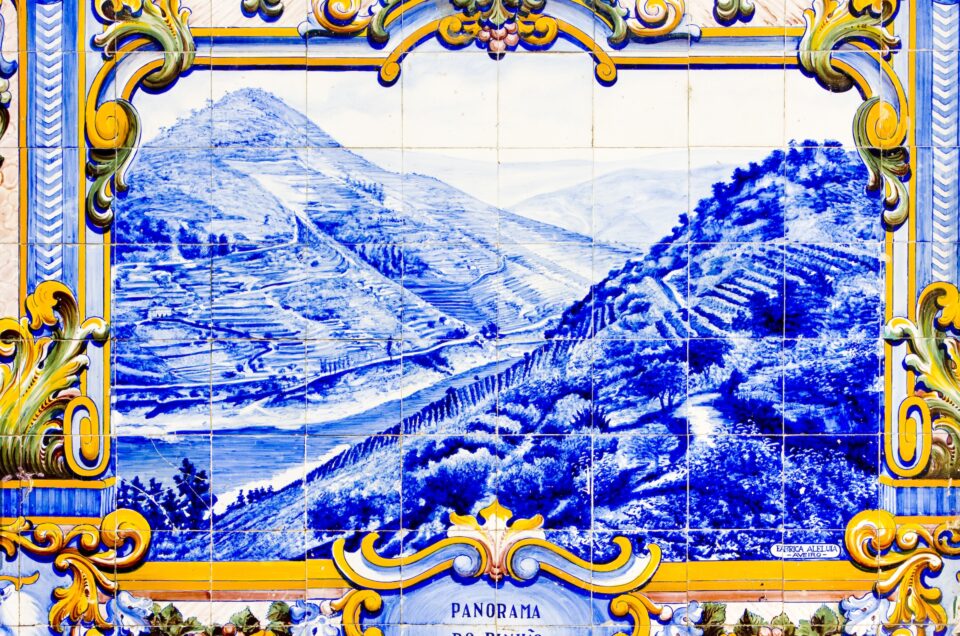From Lisbon’s shimmering façades to Porto’s grand train station and Coimbra’s scholarly cloisters, Portugal is a country where art is built into the walls. Azulejos, the hand-painted tiles that define Portugal’s identity, are more than decoration. They are history told in ceramic.
For travelers enchanted by their beauty, Portugal offers entire cities where azulejos are not just admired but lived. Following a “tile trail” across the country reveals their evolution: Moorish-inspired geometry, Renaissance flourishes, baroque storytelling, and modern interpretations that prove this tradition is alive and thriving.
At Portugal Magik Private Tours, we often curate journeys for guests who want to see Portugal through the lens of its tiles. Traveling in luxury Mercedes-Benz vehicles, guided by experts, they move seamlessly from city to city, discovering the masterpieces of azulejo art while enjoying the comfort of private, tailor-made experiences.
Here, we share the best cities in Portugal for azulejo lovers — an itinerary of culture, color, and craft.
Lisbon: The Capital of Azulejos
If Portugal has a tile capital, it is Lisbon. The city is an open-air museum where azulejos adorn façades, churches, palaces, and fountains.
Must-See Highlights
-
National Azulejo Museum (Museu Nacional do Azulejo): Housed in the Convent of Madre de Deus, this museum traces the entire history of tiles from the 15th century to the present. Its highlight is a 23-meter-long panorama of Lisbon before the 1755 earthquake.
-
São Vicente de Fora Monastery: Known for its extraordinary cloisters decorated with 18th-century azulejos depicting fables of La Fontaine.
-
Alfama & Mouraria: Wander these neighborhoods to see tiles adorning everyday houses, from religious panels above doorways to rhythmic geometric repeats.
-
Palácio dos Marqueses de Fronteira: A hidden gem on Lisbon’s outskirts, this palace has gardens filled with tile panels of hunting scenes, kings, and allegories — one of Portugal’s most beautiful azulejo collections.
The Shopping & Workshop Scene
Lisbon also excels in workshops and boutiques:
-
Sant’Anna Factory: Established in 1741, it still produces tiles by hand.
-
Viúva Lamego: Founded in 1849, it blends tradition with contemporary design, supplying tiles for both heritage buildings and modern architecture.
-
Cortiço & Netos: A boutique that sells reclaimed tiles salvaged from Lisbon demolitions, each carrying fragments of the city’s history.
For many travelers, Lisbon is not just a starting point but a destination where they paint their own tile under the guidance of artisans — an experience we often arrange privately at Portugal Magik.
Porto: Tiles on a Monumental Scale
If Lisbon is about intimacy, Porto is about grandeur. Here, tiles cover entire walls with historical narratives that unfold like epic novels.
Must-See Highlights
-
São Bento Train Station: Perhaps the most famous tile site in Portugal. Its entrance hall is lined with 20,000 tiles depicting Portuguese history, from medieval battles to pastoral scenes.
-
Igreja do Carmo: Its exterior wall is covered in one of Porto’s most iconic blue-and-white tile panels.
-
Igreja de Santo Ildefonso: An 18th-century baroque church with a striking façade covered in azulejos.
-
Capela das Almas: Known as the Chapel of Souls, its façade tells stories of saints in brilliant blue and white.
The Contemporary Touch
Porto also has a modern tile movement. At the Serralves Museum, contemporary artists reinterpret azulejos for new audiences. Around the city, you’ll also find tile-inspired street art — a dialogue between tradition and urban culture.
Coimbra: The Scholarly Language of Tiles
Coimbra, Portugal’s university city, has its own azulejo dialect. Here, tiles are scholarly, symbolic, and steeped in Renaissance humanism.
Must-See Highlights
-
University of Coimbra: A UNESCO World Heritage Site, its buildings feature remarkable tiles, particularly in the Joanina Library and the Chapel of São Miguel.
-
Sé Velha (Old Cathedral): Cloisters adorned with geometric and floral motifs.
-
Convento de Santa Clara-a-Velha: Ruins enhanced with tiled fragments that hint at the city’s layered history.
Unique Character
Coimbra’s tiles often blend classical motifs with Christian iconography, reflecting the intellectual crosscurrents of a city that was once Portugal’s capital. For travelers, it offers a more contemplative experience — less grand than Porto, but deeply symbolic.
Évora: Alentejo’s Ceramic Soul
In the sun-drenched Alentejo, Évora offers yet another chapter in Portugal’s tile story. A UNESCO World Heritage city, it combines Roman ruins, medieval streets, and baroque churches where azulejos shine.
Must-See Highlights
-
Palácio de Dom Manuel: Renaissance tilework in one of Évora’s most historic buildings.
-
Igreja de São Francisco: Known for its striking interior and famous Chapel of Bones, its cloisters feature azulejos that balance somber reflection with artistry.
-
Évora Cathedral: Subtle but beautiful tile panels complementing the Gothic and baroque architecture.
Rustic Heritage
Beyond monumental sites, Évora and the surrounding Alentejo showcase simpler, rustic tile traditions. In local houses and fountains, tiles often bear folk motifs — suns, stars, and flowers — that connect directly to rural life.
For travelers, Évora is where the grandeur of Portugal’s azulejos meets their humbler, more intimate expressions.
Reading the Trail: What the Cities Reveal
Following the tile trail across Lisbon, Porto, Coimbra, and Évora reveals more than beauty. It unveils evolution:
-
Lisbon: The heart of azulejo heritage, intimate and varied.
-
Porto: Monumental, civic, and nationalistic.
-
Coimbra: Intellectual, symbolic, and scholarly.
-
Évora: Rustic, regional, and soulful.
Together, they show how tiles are not just art but reflections of Portugal’s identity across geography and centuries.
Why Luxury Travelers Love the Tile Trail
For discerning travelers, the tile trail offers qualities that define cultural luxury: authenticity, immersion, and exclusivity. It is not about rushing from monument to monument, but about pausing to read the walls, to notice brushstrokes, to understand symbols.
As one Portugal Magik guest from Los Angeles reflected after her journey: “I came for the beauty, but I left with stories. Once you learn to read tiles, Portugal feels like an open book.”
Portugal Magik: Curating the Journey
At Portugal Magik Private Tours, we transform the tile trail into an unforgettable experience. Guests travel in the comfort of luxury Mercedes-Benz vehicles, with English-speaking driver-guides who not only show the sites but decode the symbols and stories.
We arrange private museum visits, hands-on workshops, and shopping experiences in ateliers. Itineraries are customizable — some guests prefer a focused day trip from Lisbon, while others enjoy a multi-day cultural immersion combining tiles with gastronomy, wine, and heritage towns.
The beauty of private touring is flexibility: we move at your pace, weaving the tile story seamlessly into a broader exploration of Portugal.
Conclusion: Portugal in Ceramic Storytelling
Tiles are Portugal’s poetry in ceramic — verses of history, faith, and daily life written across walls. Following their trail across Lisbon, Porto, Coimbra, and Évora reveals a cultural journey as profound as it is beautiful.
For travelers who love art, history, and meaning, the tile trail is not just an itinerary. It is a revelation — a chance to see Portugal not with tourist eyes, but with the eyes of an artisan, a historian, and a storyteller.
At Portugal Magik, we invite you to follow this trail with us, in comfort, privacy, and depth — to let the tiles whisper their stories to you.
Book Your Portugal Experience:
-
Explore our bestseller tours: Multi-Day Tours
-
Best Private Day Tours Around Lisbon: Private Day Tours
-
Read Top Guests Reviews: Reviews
-
Contact Us: Contact
-
Or simply fill in the form below to request your custom itinerary.






